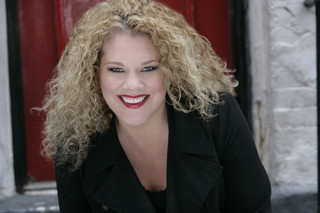|
Back
Ghostly Bach, artful Wagner, rapturous Brahms Ottawa
Southam Hall, National Arts Centre
11/26/2014 - & November 27, 2014
Johann Sebastian Bach: “Erbarme dich” from St. Matthew Passion, BWV 244
Richard Wagner: Wesendonck Lieder
Johannes Brahms: Symphony No. 4 in E minor, Op. 98
Michelle DeYoung (mezzo-soprano)
National Arts Centre Orchestra, Pinchas Zukerman (conductor and violin)

M. DeYoung (Courtesy of NACO)
Pinchas Zukerman returned to the podium at his home base, following a tour of the UK with the National Arts Centre Orchestra. The program featured eighteenth and nineteenth century German repertoire and the first half featured guest vocalist Michelle DeYoung, a rising American mezzo-soprano who focusses on concert repertoire, though also performs in opera. Her striking, often stentorian voice certainly invites the latter, and her powerful upper register suggests she could pass for a dramatic soprano, should she wish.
Erbarme dich from Bach’s monumental St. Matthew Passion initiated the evening, a short, though pivotal aria, the title translating as Have mercy, Lord. The mood is quietly sustained and low key, almost ghostly. As always Zukerman knows how to get the best from his string players when soft, gossamer sound is required, and his own brief solo also was appropriately muted. DeYoung’s singing was another matter. Her decidedly big voice may not be ideal for this music, though it was obvious she was scaling things down to accommodate the requisite mood and sound. Her vibrato, however, was a bit too operatic to work comfortably with this score, or with the discreet accompaniment.
The Wesendonck Lieder, composed when Wagner was working on Tristan und Isolde, also seemed to challenge the performers, though in unlikely ways. The orchestra again was off to a wonderful opening with delicate pianissimos and an accompaniment which almost floated from the stage toward the audience. In the first two songs, The Angel and Be Quiet! DeYoung’s singing was generally competent and coped well with the borderline storm which the latter invokes.
Balance between her singing and the orchestra suddenly and dramatically improved in the third song, In the Hothouse, with its teasing, constantly descending harmonics, then in Anguish with even more elaborately shifting tonalities. DeYoung found an artistic and an acoustic confidence which eluded her earlier and brought consistently artful, finely wrought phrasing to the final song, Dreams, which suited well the delicately fragmented vocal line Wagner created here.
After intermission, it was Brahms’ Symphony No. 4, the composer’s final such work; Zukerman’s live performances this week are being recorded for future CD release. In the opening movement he opted for a full bodied approach and there was rather less string detail than we usually hear under his conducting. Zukerman put particular focus on Brahms’ inventive, cumulative reworking of the opening melody with its brief two-note phrases. The composer was determined to wrestle every imaginable permutation on his materials and the development section in particular has noteworthy parallels to Tchaikovsky’s Symphony No. 4, composed a few years earlier (though Tchaikovsky was accused by some critics of padding in the work). Overall though, Brahms preferred to keep his larger scale compositions ultimately more compact and his Symphonies never aspired to the jumbo structures with which, sometimes if not always, Tchaikovsky, Bruckner and Mahler challenged themselves, taking their cue from Beethoven’s Ninth.
The second movement revealed finer balance among the orchestra’s sections, beautifully illustrating Brahms at his most concurrently sensual and intellectually sophisticated. The third movement, in quarter time, is a not-quite Scherzo having an ecstatic quality that is always memorable, and possibly the only time Brahms used the triangle among his percussion resources. The final movement, much like the first, is characterized by the orchestra’s sections almost constantly taking turns at developing the material. Again, there may be some parallels with Tchaikovsky, whose Symphony No. 5 (also in E minor) was composed just three years later, and which Ottawa concertgoers heard recently from China’s National Centre for the Performing Arts Orchestra.
Overall, Brahms’ Symphony No. 4 is a deceptively subtle and concise masterpiece and, arguably, more challenging than some of the more overtly grandiose works by others. Zukerman and his players have a solid handle on it. If the November 26 performance didn’t quite manage a home run, it was more often than not rewarding (especially the second and third movements) and communicated strongly and effectively with the audience whose response at the concert’s end was rapturous.
Charles Pope Jr.
|